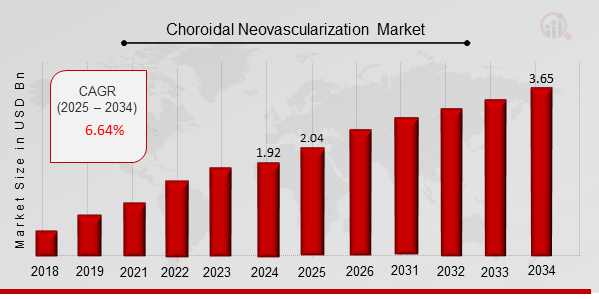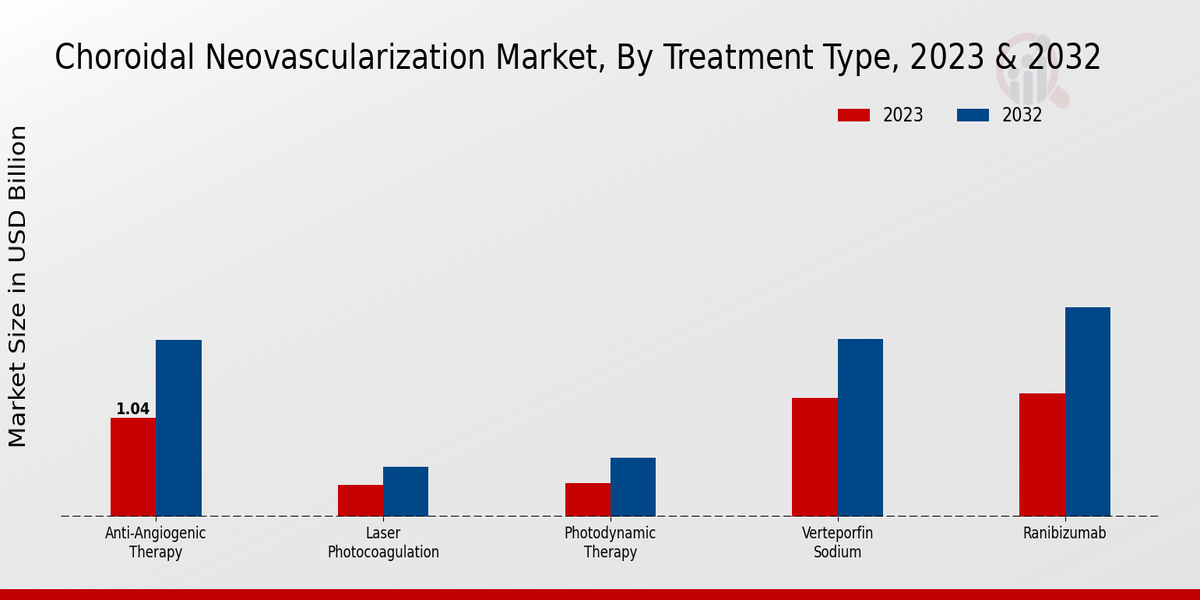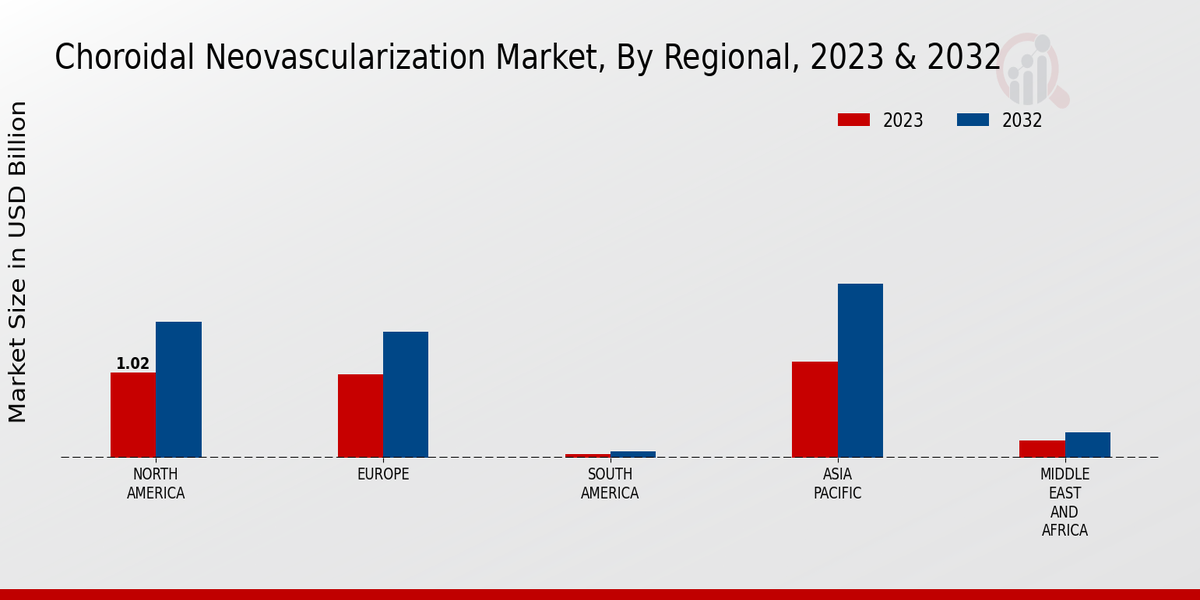Choroidal Neovascularization Market Overview
As per MRFR analysis, the Choroidal Neovascularization Market Size was estimated at 1.92 (USD Billion) in 2024. The Choroidal Neovascularization Market Industry is expected to grow from 2.04 (USD Billion) in 2025 to 3.65 (USD Billion) till 2034, at a CAGR (growth rate) is expected to be around 6.64% during the forecast period (2025 - 2034).
Key Choroidal Neovascularization Market Trends Highlighted
The global choroidal neovascularization (CNV) market is experiencing significant growth, driven by advancements in treatment options and the increasing prevalence of age-related macular degeneration (AMD), a major cause of CNV.
Recent trends include the emergence of intravitreal anti-VEGF therapies, and gene therapy approaches, offering improved efficacy and reduced treatment burden.
Moreover, the growing adoption of optical coherence tomography angiography (OCTA) for early detection and monitoring of CNV is enhancing diagnostic capabilities and facilitating timely intervention.
Opportunities lie in the development of combination therapies, personalized treatment strategies based on genetic profiles, and the exploration of novel targets for CNV inhibition.
With these advancements, the market for CNV management is expected to witness continued growth in the coming years.

Source: Primary Research, Secondary Research, Market Research Future Database and Analyst Review
Choroidal Neovascularization Market Drivers
Increasing Prevalence of Age-Related Macular Degeneration (AMD)
Age-related macular degeneration is one of the widespread causes of vision loss in people over 50. It is a prevailing condition among individuals where the macula, the center part of the retina that is responsible for sharp central vision, deteriorates.
Choroidal neovascularization is the growth of abnormal blood vessels emerging beneath the macula. It appears in almost 10-15% of patients with AMD. It is associated with leakage of fluids and blood, scarring among improper perfused vessels, and may cause visionary damage.
The growing amount of age-related macular degeneration cases is a vital stimulant of the Choroidal Neovascularization Market.
Technological Advancements in Diagnostic and Therapeutic Options
Technological advancements have been vital in the diagnosis and treatment of choroidal neovascularization. Optical coherence tomography and fluorescein angiography are some of the imaging methods commonly employed in Choroidal Neovascularization (CNV).
Consequently, the Optometrist can visualize CNV and keep track of its development. Moreover, Anti-vascular endothelial growth factor has transformed CNV’s treatment.
Anti-vascular Endothelial Growth Factor drugs can block VEGF, a protein that incites more blood vessels to grow, from working, thus decreasing the amount of leakage and improving vision. Hence, the Market will expand because of fresh and more effective diagnostic and therapeutic options.
Rising Healthcare Expenditure and Government Support
The Choroidal Neovascularization Market is growing due to rising healthcare expenditure and government support. The expenditure on health is growing, which is expected to drive the demand for new and advanced treatments for diseases.
In addition, governments of many countries are increasing their spending on eye care and research and development. This will result in the development of new treatments and technology for helping patients suffering from choroidal neovascularization.
Choroidal Neovascularization Market Segment Insights
Choroidal Neovascularization Market Treatment Type Insights
The Choroidal Neovascularization Market is segmented by Treatment Type into Anti-Angiogenic Therapy, Laser Photocoagulation, Photodynamic Therapy, Verteporfin Sodium, Ranibizumab, Bevacizumab, Aflibercept, and Pegaptanib Sodium.
Anti-Angiogenic Therapy is expected to hold the largest market share in the Choroidal Neovascularization Market due to its effectiveness in preventing the growth of new blood vessels that supply the choroidal neovascularization. One of the other widely used treatments in the market is the Laser Photocoagulation, which involves destroying the choroidal neovascularization with the use of a laser.
Photodynamic Therapy is one of the minimally invasive treatment options available in the market, which employs a light-activated drug for destroying choroidal neovascularization. Verteporfin Sodium is a photosensitizing agent used in Photodynamic Therapy.
Ranibizumab, Bevacizumab, and Aflibercept are the anti-VEGF agents that are approved for the treatment of choroidal neovascularization. Pegaptanib Sodium is the other anti-VEGF agent used for the treatment of choroidal neovascularization.
The Choroidal Neovascularization Market is expected to grow in the coming years due to the increasing prevalence of age-related macular degeneration.
The other major proven cause of choroidal neovascularization is angioid streaks that are caused by the side effects of pseudoexfoliation syndrome. The key drivers are the rising use of advanced treatments like anti-aging therapy and Photodynamic Therapy.

Source Primary Research, Secondary Research, Market Research Future Database and Analyst Review
Choroidal Neovascularization Market Indication Insights
The Choroidal Neovascularization Market segmentation by Indication comprises Age-Related Macular Degeneration (AMD), Diabetic Macular Edema (DME), Central Serous Chorioretinopathy (CSC), Polypoidal Choroidal Vasculopathy (PCV), Myopic Macular Degeneration (MMD), and Other Indications.
Among these, AMD is expected to hold the largest market share due to its high prevalence and increasing geriatric population.
DME is another major indication driven by the rising incidence of diabetes worldwide. CSC and PCV are also significant contributors to the market, with growing awareness and advancements in treatment options.
The "Other Indications" segment includes conditions such as ocular histoplasmosis syndrome, angioid streaks, and presumed ocular histoplasmosis syndrome, which collectively account for a smaller market share.
Choroidal Neovascularization Market Route of Administration Insights
The Choroidal Neovascularization Market is segmented by Route of Administration into Intravitreal, Subconjunctival, Periocular, and Oral.
Among these, the Intravitreal segment held the largest market share in 2023 and is expected to maintain its dominance throughout the forecast period.
This is attributed to the high efficacy and tolerability of intravitreal injections for treating choroidal neovascularization.
The Subconjunctival segment is projected to register the highest CAGR during the forecast period, owing to the increasing adoption of sustained-release subconjunctival implants for long-term drug delivery. The Periocular and Oral segments are expected to witness moderate growth over the forecast period.
Choroidal Neovascularization Market End User Insights
The End User segment of the Choroidal Neovascularization Market is expected to exhibit significant growth in the coming years.
Hospitals are anticipated to dominate the market, owing to factors such as the increasing number of patients seeking treatment for choroidal neovascularization, the availability of advanced diagnostic and treatment facilities, and the presence of skilled healthcare professionals in these settings.
Furthermore, the growing adoption of minimally invasive procedures, such as anti-VEGF injections and laser therapy, is contributing to market growth.
Ophthalmology clinics are projected to witness a substantial market share due to their specialized services and expertise in treating eye disorders. Ambulatory surgical centers are expected to gain traction as they offer convenience and cost-effective treatment options for patients.
Research centers play a crucial role in advancing the understanding of choroidal neovascularization and developing novel treatment modalities. Their contributions to clinical trials and research studies are expected to drive market growth in the future.
Choroidal Neovascularization Market Regional Insights
The regional landscape of the Choroidal Neovascularization Market showcases distinct growth trajectories across key regions.
North America dominates the market with a significant revenue share, driven by factors such as the rising prevalence of age-related macular degeneration, advanced healthcare infrastructure, and increasing adoption of novel therapies.
Europe follows closely, with a substantial market presence fueled by government initiatives, reimbursement policies, and a growing aging population.
The Asia-Pacific (APAC) region is poised for substantial growth, attributed to a large patient pool, increasing healthcare expenditure, and the emergence of local manufacturers.
South America and the Middle East and Africa (MEA) regions are expected to witness steady growth, driven by government initiatives and increasing awareness about choroidal neovascularization.
These regional insights provide valuable information for market players to tailor their strategies and target specific geographies for growth and expansion.

Source Primary Research, Secondary Research, Market Research Future Database and Analyst Review
Choroidal Neovascularization Market Key Players and Competitive Insights
The major players in the Choroidal Neovascularization Market are focused continuously on the development of novel therapeutic approaches to address the unmet medical needs of patients with CNV.
Leading Choroidal Neovascularization Market players are involved in clinical trials, research collaborations, and strategic partnerships to fortify their product portfolios and expand their market presence.
The competitive Choroidal Neovascularization Market landscape is a mix of both established pharmaceutical companies and emerging biotechnology ventures. Novartis, Bayer, Roche, Regeneron, and Allergan are the key players in the Choroidal Neovascularization Market.
These companies are spending on research and development activities to develop innovative therapies targeting the underlying cause of CNV and improve patient outcomes. The Choroidal Neovascularization Market has excellent growth potential in the upcoming years due to the growing prevalence of age-related macular degeneration and diabetic retinopathy and the development of novel therapeutic approaches.
Novartis is one of the leading players in the Choroidal Neovascularization Market with a strong presence in ophthalmology. The company’s present portfolio includes Lucentis ranibizumab, which is a VEGF inhibitor approved for the treatment of wet age-related macular degeneration and other retinal diseases.
Novartis has a robust pipeline of new therapies for CNV, including brolucizumab, a new drug showing superior effects in clinical trials. This new drug is also a strong contender for a blockbuster position in the near future. Novartis’ POS is high due to its strong commercial presence and commitment to innovation.
Bayer is another prominent player in the Choroidal Neovascularization Market with a stronghold in ophthalmology. The company’s present portfolio includes Eylea aflibercept, a VEGF inhibitor approved for the treatment of wet age-related macular degeneration, diabetic retinopathy, and other retinal diseases.
The company's current drug being developed for CNV is farcical. The biggest strength of Bayer in the Choroidal Neovascularization Market is its strong product portfolio and commitment to Research and Development.
Key Companies in the Choroidal Neovascularization Market Include
- Regeneron Pharmaceuticals, Inc.
- Janssen Pharmaceuticals, Inc.
- Santen Pharmaceutical Co., Ltd.
- Teva Pharmaceutical Industries Ltd.
- Apellis Pharmaceuticals, Inc.
Choroidal Neovascularization Market Developments
Key factors driving this growth include the increasing prevalence of age-related macular degeneration (AMD), the leading cause of CNV, as well as advancements in treatment modalities such as anti-vascular endothelial growth factor (VEGF) therapies.
Geographic regions with high geriatric populations, such as North America and Europe, are expected to hold significant market shares.
Recent developments in the CNV market include the approval of novel anti-VEGF agents with improved efficacy and safety profiles, as well as the emergence of gene therapy approaches targeting the underlying genetic causes of CNV.
Choroidal Neovascularization Market Segmentation Insights
Choroidal Neovascularization Market Treatment Type Outlook
Choroidal Neovascularization Market Indication Outlook
- Age-Related Macular Degeneration (AMD)
- Diabetic Macular Edema (DME)
- Central Serous Chorioretinopathy (CSC)
- Polypoidal Choroidal Vasculopathy (PCV)
- Myopic Macular Degeneration (MMD)
Choroidal Neovascularization Market Route of Administration Outlook
Choroidal Neovascularization Market End User Outlook
- Ambulatory Surgical Centers
Choroidal Neovascularization Market Regional Outlook
| Report Attribute/Metric |
Details |
|
Market Size 2024
|
1.92 (USD Billion)
|
|
Market Size 2025
|
2.04 (USD Billion)
|
|
Market Size 2034
|
3.65 (USD Billion)
|
|
Compound Annual Growth Rate (CAGR)
|
6.64 % (2025 - 2034)
|
|
Report Coverage
|
Revenue Forecast, Competitive Landscape, Growth Factors, and Trends
|
|
Base Year
|
2024
|
|
Market Forecast Period
|
2025 - 2034
|
|
Historical Data
|
2020 - 2024
|
| Market Forecast Units |
USD Billion |
| Key Companies Profiled |
Regeneron Pharmaceuticals, Inc., Oxurion NV, Iveric Bio, Inc., Roche Holding AG, Janssen Pharmaceuticals, Inc., Alcon Laboratories, Inc., Genentech, Inc., Carl Zeiss Meditec AG, Allergan, Santen Pharmaceutical Co., Ltd., Topcon Corporation, Teva Pharmaceutical Industries Ltd., Apellis Pharmaceuticals, Inc., Bayer AG, Novartis AG |
| Segments Covered |
Treatment Type, Indication, Route of Administration, End User, Regional |
| Key Market Opportunities |
Rising prevalence of AMD Development of Advanced Therapies Growing Demand for Minimally Invasive Procedures Technological Advancements Favorable Reimbursement Policies |
| Key Market Dynamics |
Rising prevalence of age-related macular degeneration Technological advancements in diagnostics and treatment Growing geriatric population Increasing government initiatives for eye care Expansion of healthcare infrastructure in developing regions |
| Countries Covered |
North America, Europe, APAC, South America, MEA |
Frequently Asked Questions (FAQ):
The Choroidal Neovascularization Market reached a valuation of approximately USD 1.68 billion in 2023.
The Choroidal Neovascularization Market is projected to exhibit a CAGR of approximately 6.64% from 2025 to 2034.
The Choroidal Neovascularization Market is projected to reach a valuation of approximately USD 3.65 billion by 2034.
North America is expected to dominate the Choroidal Neovascularization Market throughout the forecast period.
The anti-VEGF segment is expected to hold the largest market share in the Choroidal Neovascularization Market.
Some of the key competitors in the Choroidal Neovascularization Market include Novartis AG, Regeneron Pharmaceuticals Inc, Bayer AG, F. Hoffmann-La Roche Ltd, and Allergan.
Rising prevalence of age-related macular degeneration and diabetic retinopathy, technological advancements, and increasing healthcare expenditure are the major factors driving the growth of the Choroidal Neovascularization Market.
High cost of treatment, side effects associated with anti-VEGF therapies, and stringent regulatory policies are the major challenges faced by the Choroidal Neovascularization Market.
Growing geriatric population, increasing awareness about the disease, and development of novel therapies are the major opportunities for the Choroidal Neovascularization Market.
Increasing adoption of combination therapies, personalized medicine, and advancements in gene therapy are the key trends in the Choroidal Neovascularization Market.

















